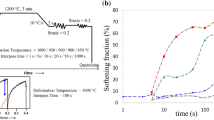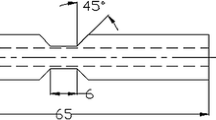Features of structure and property formation are studied for cold-rolled product in two-phase ferriticmartensitic steels by modeling heat treatment in a continuous annealing unit (CAU) of six laboratory melts of different chemical composition intended for preparing steels of different strength classes according to EN10338:2013. Steel of some melts, apart from alloying with elements currently used extensively, are additionally alloyed with aluminum. Hot- and cold-rolling processing regimes simulate those used under production conditions. Results of modeling heat treatment in a CAU by different regimes show an increase in strength and a reduction in ductility properties with a reduction in overageing temperature. Rolled product of steel alloyed with aluminum has lower strength properties, ratio of yield to ultimate strengths, but better relative elongation values.





Similar content being viewed by others
References
W. Bleck, “Using the TRIP effect – the dawn of a promising new group of cold formable sheets,” Int. Conf. on TRIPAided High Strength Ferrous Alloys, B. C. De Cooman (ed.), GRIPS, Ghent (2002), pp. 13–23.
J. Adamczyk and A. Grajcar, “Heat treatment and mechanical properties of low-carbon steel with dual-phase microstructure,” J. Achiev. Mater. Manufact. Eng., 22, 13–20 (2007).
M. Calcagnotto, D. Ponge, and D. Raabe, “On the effect of manganese on grain size stability and hardenability in ultrafi ne-grained ferrite/martensite dual-phase steels,” Metal. and Mat. Trans. A, 43, No. 1, 37–46 (2012).
A. Pichler, “TRIP steels with reduced Si content,” J. Steel Res., 70, No. 1,, 459–465 (1999).
M. De Meyer, D. Vanderschueren, and B. C. De Cooman, “The influence of the substitution of Si by Al on the properties of cold rolled C–Mn–Si TRIP steels,” ISIJ Int., 39, No. 8, 813–822 (1999).
NF EN 10338-2015, Hot Rolled and Cold Rolled Non-Coated Flats Products of Multiphase Steels for Cold Forming – Technical Delivery Conditions, enacted 10.16.2015.
Author information
Authors and Affiliations
Corresponding author
Additional information
Translated from Metallurg, No. 6, pp. 48–54, June, 2016.
Rights and permissions
About this article
Cite this article
Nishchik, A.V., Yashchuk, S.V., Baklanova, O.N. et al. Effect of Treatment Temperature Regimes in a Continuous Annealing Unit on Two-Phase Ferritic-Martensitic Steel Mechanical Properties. Metallurgist 60, 594–601 (2016). https://doi.org/10.1007/s11015-016-0337-0
Received:
Published:
Issue Date:
DOI: https://doi.org/10.1007/s11015-016-0337-0




